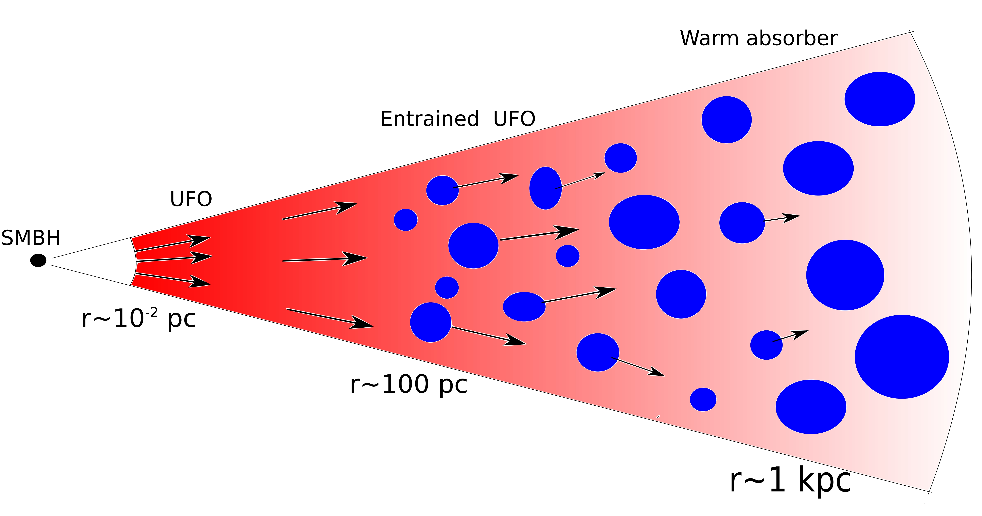'UFOs' Are Flying Out from Supermassive Black Holes and Reshaping Galaxies
These jets of matter act like snowplows that shove gas around inside galaxies. And for the first time astronomers have spotted it happening.

Hot ionized gas is streaming out of the accretion disk of a supermassive black hole and slamming into its surroundings at a significant fraction of the speed of light. And this kind of ultra-fast outflow (UFO) might explain the nearly empty darkness that surrounds the center of many galaxies, astronomers now say.
These astronomers base their argument, published in the July issue of the journal Astronomy and Astrophysics, on a new observation of galaxy PG 1114+445 from the European Space Agency's X-ray Multi-Mirror Mission (XMM-Newton) telescope . For the first time, the researchers were able to snap an image of UFOs pushing other material around at the heart of a galaxy.
Their observations showed that energy was being transferred from the UFO to other winds near the black hole, pushing that wind to incredible speeds. This is important, the researchers wrote, because it could explain a long-standing mystery about supermassive black holes: The bigger the supermassive black hole, the faster the inner stars in its host galaxy move. Gravity alone can't explain this relationship, but if the larger black holes spew more intense outflows that shove out gas at higher speeds, they could also be sweeping away nearby stars and accelerating them to higher speeds.
Related: 9 Ideas About Black Holes That Will Blow Your Mind
To make this first-of-its-kind observation, the researchers imaged a UFO alongside two other types of outflows near the black hole: "warm absorbers," which travel much more slowly and are less ionized, and rare "entrained UFOs," which are the result of UFOs mixing with both the warm absorbers and loose matter floating between stars. Entrained UFOs are rare; this is only the sixth time one has ever been spotted, and only the first time one's been spotted together with the other two kinds of outflows. The researchers said that the combined data tells a story about how UFOs interact with interstellar space.
"The inner UFO carries a very large amount of both momentum and energy," said study author Roberto Serafinelli, an astronomer at the Brera Astronomical Observatory in Milan, Italy. "[It] is extremely ionized gas — the iron is stripped of all but one or two of its 26 electrons — and is launched at extremely high speed — [about] 15% the speed of light — from the innermost parts of the accretion disk, very close to the supermassive black hole."

Researchers can see the outflow's extreme momentum in "absorption lines" from the light it reflects. Here's how that works: Chemicals, like iron, absorb some wavelengths of light more than others. Researchers can see dips in energy (or "absorption lines") at those wavelengths in the light coming from an object when those chemicals are present – but when the chemical moves fast enough, the wavelengths of light from that object are stretched, or "redshifted." All of the wavelengths get longer, and as a result, the absorption lines turn up at unusual places on the spectrum: Instead of an absorption line at the usual spot for iron on the spectrum, redshifting would make an absorption line turn up at a longer wavelength. The difference between where the absorption line would normally show up and where the actual line appears reveals how stretched the light was. That, in turn, tells scientists how fast the object the light came from was moving, Serafinelli told Live Science. In the case of these UFOs, the absorption lines were intensely redshifted, indicating very high speeds.
Get the world’s most fascinating discoveries delivered straight to your inbox.
It turns out that the entrained UFO has the same chemical composition as the warm absorber, Serafinelli said, which means that the UFO traveled thousands of years through space just to slam into the warm absorber, creating the entrained UFO in the process.
Because this is only the first time researchers have seen the three outflows together in one place, they can say with certainty only that this effect is happening in galaxy PG 1114+445. And they were only able to see the three flows thanks to the telescope XMM-Newton, Serafinelli said, because it has a sharp enough "energy resolution" to precisely mark the speeds of the different outflows. The next step, he said, is to find similar outflow combinations in other galaxies, and confirm that UFOs are really having this dramatic effect on their interstellar neighbors.
- 11 Fascinating Facts About Our Milky Way Galaxy
- Big Bang to Civilization: 10 Amazing Origin Events
- Spaced Out! 101 Astronomy Photos That Will Blow Your Mind
Originally published on Live Science.



